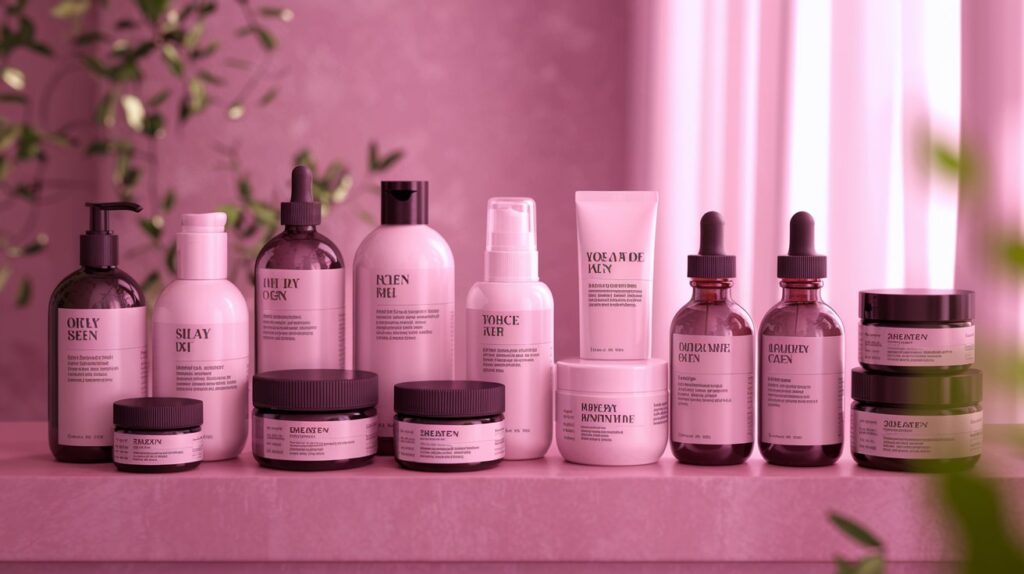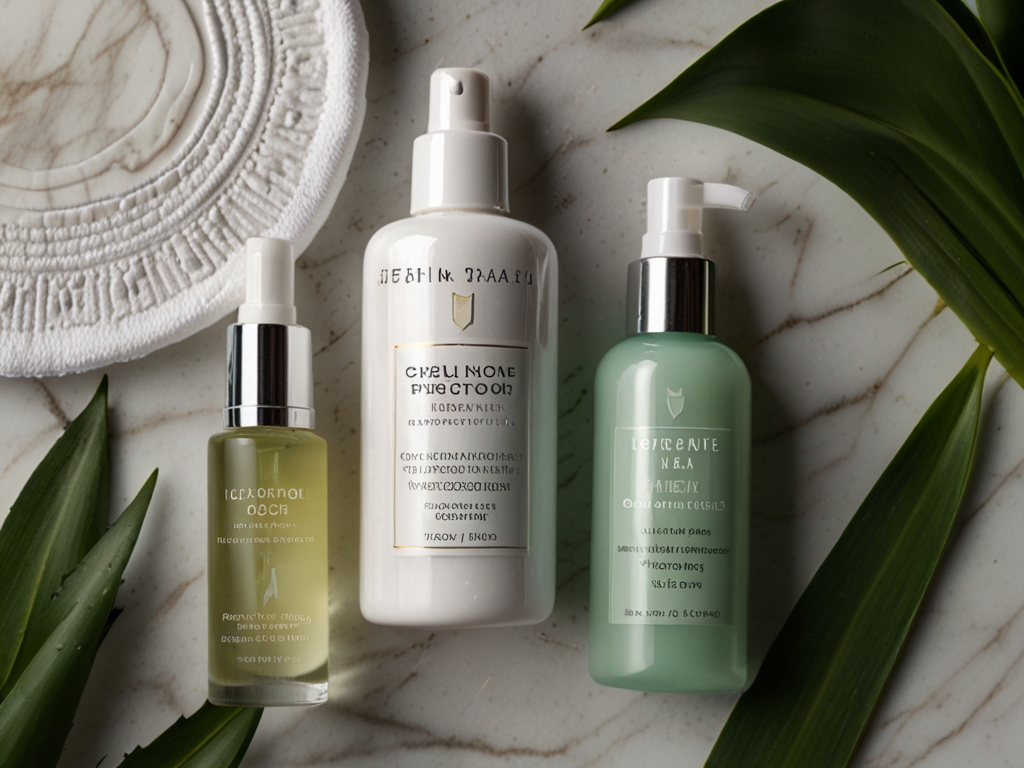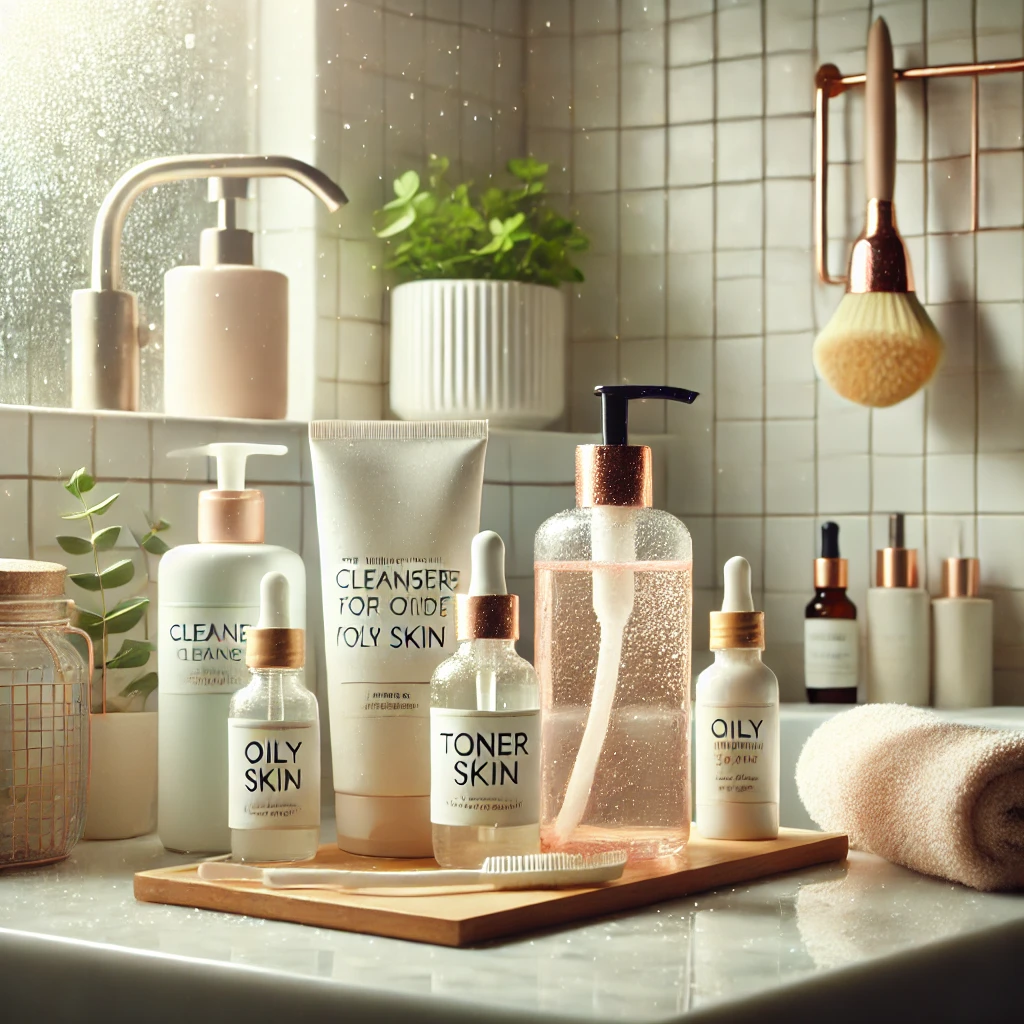Introduction
Oily skin can be tough to handle, causing shine and acne. This guide aims to help you manage your oily skincare. We’ll share key info and expert advice for a good skincare routine.
Our team includes writers and beauty experts from various backgrounds. We’ll cover oily skin’s causes, signs, and treatments. Remember, all skin types need moisture, but oily skin needs special care. Sandra Lee says, “All skin types need moisturizer, but if you have oily skin, you should be more careful with what kind of moisturizer you’re using.” Let’s explore the best skincare tips for oily skin and find ways to get a healthy glow.

Understanding Oily Skin
Understanding oily skin starts with knowing its characteristics. It often comes from too much sebum, thanks to androgens—male hormones in everyone. This makes the skin look shiny or greasy, usually within a few hours after washing.
Big pores, especially on the T-zone (nose, chin, and forehead), are also common. This area tends to get oily more easily.
People with this kind of skin often face oily skin issues like acne and blackheads. It’s a mistake to think drying out the skin will help. Instead, it can make things worse by producing more oil.
So, picking the right skincare is key. Fragrance-free cleansers help avoid irritation. Salicylic acid, a beta hydroxy acid, is great for removing dead skin and unclogging pores.
Also, using a day cream with sun protection is important. It helps prevent wrinkles and reduces inflammation.
- Recognizing enlarged pores on the T-zone
- Monitoring the shine or greasy feel developing shortly after cleansing
- Identifying breakout-prone areas of the skin
In summary, knowing about this kind of skin and the right skincare can greatly improve your skin’s health. Using products that soak up sebum and choosing gel or lotion moisturizers helps manage oily skin. This knowledge leads to better skincare habits.
Common Causes of Oily Skin
Many causes of oily skin make it shiny and greasy. Genetics are a big factor, as oily skin often runs in families. If your family has oily skin, you might get it too.
Hormonal changes also play a big role. Changes in hormones, like during puberty or pregnancy, can make your skin produce more oil.
What you eat can also affect your skin. Eating a lot of dairy and sugars can make your skin oilier, especially for young women. Some skincare product ingredients can make things worse. Products with alcohol can irritate your skin, making it produce more oil.
| Factor | Description |
|---|---|
| Genetics | Family history may increase likelihood of oily skin. |
| Hormonal Effects | Fluctuations in hormones can lead to increased sebum production. |
| Diet | High intake of dairy and sugars can correlate with oilier skin. |
| Product Ingredients | Alcohol-based products may trigger more oil production. |
Knowing what causes oily skin helps you make better choices for your skin and life. Talking to a dermatologist can give you advice on how to manage oily skin and find the right treatments.
How to Identify Oily Skin
Knowing if you have oily skin is key to a good skincare routine. Oily skin symptoms include a shiny look right after you wash your face. This can make your skin feel oily by the end of the day.
Look for big pores, especially in the T-zone, which is the forehead, nose, and chin. If you get blackheads and spots often, it’s a sign of oily skin. These can be annoying.
It’s important to notice these signs. They help you choose the right products and treatments. Understanding your skin’s behavior makes your skincare routine more effective for oily skin.
| Oily Skin Symptoms | Description |
|---|---|
| Shiny Appearance | Skin exhibits a glossiness, particularly in the T-zone, shortly after cleansing. |
| Enlarged Pores | Pores appear larger and more noticeable, especially on the forehead, nose, and chin. |
| Blackheads | Frequent blackheads develop due to excess oil clogging pores. |
| Spots and Pimples | Increased breakouts due to oil production promoting acne formation. |
The Importance of a Skincare Routine for Oily Skin

Having a skincare routine for oily skin is key for those who want to control oil. A good daily skin care regimen helps keep sebum levels in check. It also reduces acne and clogged pores. Dermatologists suggest a four-step plan: cleanse, tone, treat, and moisturize.
Cleansing regularly removes dirt and extra oil. Toners, especially those without alcohol, get rid of any remaining dirt. Treatments with lightweight, oil-free serums help with pores and acne. A good moisturizer keeps the skin hydrated without clogging pores. Not moisturizing can make the skin produce more oil.
Using products like CeraVe Foaming Facial Cleanser and La Roche-Posay’s Toleriane Foaming Facial Cleanser is a good start. Remember, using broad-spectrum SPF 15 or higher daily is crucial for sun protection. A consistent skincare routine for oily skin leads to healthier, more balanced skin.
| Step | Purpose | Recommended Products |
|---|---|---|
| Cleansing | Remove dirt and excess oil | CeraVe Foaming Facial Cleanser, La Roche-Posay Toleriane |
| Toning | Balance pH and eliminate residue | Alcohol-free toners |
| Treating | Target acne and visible pores | Salicylic acid serums, retinol |
| Moisturizing | Hydrate and prevent excess oil | CeraVe Ultra-Light Moisturizing Lotion |
The Ultimate Skincare Guide for Oily Skin
Keeping your skin clean is key for oily skin. The right skincare routine can make your skin healthier and clearer. It also helps reduce oil and prevent breakouts. Here’s a step-by-step guide to get the best results.
Step 1: Cleansing
Cleaning your oily skin twice a day is essential. Use a gentle cleanser with salicylic acid, like Kiehl’s Rare Earth Deep Pore Daily Cleanser. It cleanses well without drying out your skin.
Step 2: Toning
Toning is crucial in your skincare routine. Use an alcohol-free toner, like Paula’s Choice Skin Balancing Pore-Reducing Toner. It helps balance your skin’s pH and prepares it for other products.
Step 3: Treating
Using products specifically for acne and oil control is important. Benzoyl peroxide or retinol are great choices. They help reduce blemishes and prevent new ones.
Step 4: Moisturizing
Don’t skip moisturizing, even if you have oily skin. Choose lightweight, non-comedogenic moisturizers, like CeraVe PM Facial Moisturizing Lotion. It keeps your skin hydrated without adding oil.
| Step | Description | Recommended Product |
|---|---|---|
| 1. Cleansing | Remove excess oils and impurities. | Kiehl’s Rare Earth Deep Pore Daily Cleanser |
| 2. Toning | Restore skin’s pH balance and enhance absorption. | Paula’s Choice Skin Balancing Pore-Reducing Toner |
| 3. Treating | Combat acne and maintain clear skin. | Benzoyl Peroxide or Retinol Treatments |
| 4. Moisturizing | Hydrate without clogging pores. | CeraVe PM Facial Moisturizing Lotion |
Best Products for Oily Skin

Finding the right products for oily skin can really improve your skincare routine. The best cleansers, toners, moisturizers, and serums help manage oil and prevent breakouts. Here are some top picks for oily skin.
Cleansers
Good cleansers for oily skin remove extra oil without drying out your skin. Look for ones with salicylic acid or benzoyl peroxide to keep pores clear. Here are some great options:
- CeraVe Foaming Facial Cleanser – Priced at $19
- PanOxyl Acne Creamy Wash – Great for deep cleaning
Toners
Toners refresh and refine your skin. They should have ingredients like niacinamide to control oil. Try these:
- Murad Clarifying Toner – Priced at $30
- Neutrogena Pore Refining Toner – Helps minimize pores
Moisturizers
Lightweight moisturizers keep oily skin hydrated without clogging pores. Look for gel-based products:
- Tatcha The Water Cream – Priced at $72
- Origins Clear Improvement Moisturizer – Hydrates and balances oil
Serums
Effective serums control oil and improve skin texture. Niacinamide and zinc are great ingredients:
- The Ordinary Niacinamide 10% + Zinc 1% Oil Control Serum – Priced at $6
- SkinCeuticals Silymarin CF – Top vitamin C serum, $182
| Product Type | Product Name | Price |
|---|---|---|
| Cleansers | CeraVe Foaming Facial Cleanser | $19 |
| Toners | Murad Clarifying Toner | $30 |
| Moisturizers | Tatcha The Water Cream | $72 |
| Serums | The Ordinary Niacinamide 10% + Zinc 1% Oil Control Serum | $6 |
Choose from these top picks for oily skin to make a balanced skincare routine.
Oily Skin Care Tips
Managing oily skin means following the right daily habits and debunking skincare myths. By using effective strategies, you can greatly improve your skin’s health. Here are some practical tips to help you keep your skin balanced and shine-free.
Daily Habits to Follow
- Cleanse your face twice a day with a gentle cleanser for oily skin. Good options include PanOxyl Acne Foaming Wash and Neutrogena Ultra Gentle Daily Cleanser.
- Use blotting papers all day to soak up extra oil without messing up your makeup or skincare.
- Apply sunscreen every day with an SPF of 30 or higher, even on cloudy days. Try Eucerin Sun Oil Control SPF 50 and ISDIN Eryfotona Actinica.
- Exfoliate twice a week, best at night, to get rid of dead skin cells. Look for products with salicylic acid for the best results.
- Add niacinamide to your routine, as it helps control oil production well.
Things to Avoid
- Stay away from heavy creams and products with alcohol, as they can clog pores and make oiliness worse.
- Avoid harsh scrubs that can irritate your skin. Gentle exfoliation is important.
- Never skip cleansing after working out. Sweat can increase oil build-up, causing breakouts.
- Don’t believe skincare myths, like thinking oily skin doesn’t need moisturizing. An oil-free, water-based moisturizer is still crucial.
Homemade Remedies for Oily Skin

Natural treatments offer many options for oily skin. Simple ingredients can tackle excess oil and irritation. These homemade remedies for oily skin help balance your complexion.
DIY skincare with honey is great because it fights bacteria. Oatmeal is also popular for soothing and exfoliating. Here are some homemade remedies you might find helpful:
- Honey and Oatmeal Face Mask: Mix equal parts of honey and oatmeal to create a paste. Apply to the face for 15-20 minutes, then rinse.
- French Green Clay Mask: Combine green clay with water to form a thick paste. Apply and let it dry before rinsing off to absorb excess oil.
- Egg White and Lemon Treatment: Whisk two egg whites and mix in a few drops of lemon juice. Apply to tighten pores and control oil.
- Aloe Vera Gel: Use fresh aloe vera or store-bought gel for its soothing effects and to hydrate oil-prone areas.
- Tomato Pulp Application: Spread fresh tomato pulp on the face. Salicylic acid in tomatoes helps clear clogged pores.
It’s important to watch how your skin reacts to these natural treatments. Some people see big improvements in their skin. Always test new ingredients first and stop if you get irritation.
Washing your face twice a day can help these remedies work better. Use water-based products and avoid oily ones to keep your skin matte. Adding homemade masks to your routine can control oil, hydrate, and even out your skin tone.
| Ingredient | Benefits |
|---|---|
| Honey | Antibacterial and natural moisturizer |
| Oatmeal | Soothes inflammation, absorbs excess oil |
| French Green Clay | Helps detoxify skin, absorbs sebum |
| Egg Whites | Tightens pores and reduces oiliness |
| Aloe Vera | Soothes and hydrates skin without added oil |
| Tomatoes | Contains salicylic acid to unclog pores |
Using these homemade remedies for oily skin regularly can help you create a skincare routine that works for you. It’s all about embracing natural ingredients.
How to Manage Oily Skin in Different Seasons
Managing oily skin needs a flexible plan, especially with the seasons changing. Seasonal skin care is key to keeping your skin balanced and preventing breakouts.
In summer, the heat and humidity make your skin produce more oil. For this, use light products. Choose gel moisturizers and oil-free sunscreens to avoid clogged pores. Salicylic acid and niacinamide help keep your skin clear and hydrated.
Daily exfoliation removes dead skin cells, revealing a brighter skin underneath.
When fall and winter come, the air gets drier, affecting moisture levels. This can cause dryness and sensitivity, so you need to adjust your routine. Use moisturizers with hyaluronic acid to keep your skin moist and prevent oiliness.
In colder months, use a thicker moisturizer or cream to keep your skin hydrated without feeling greasy.
In winter, oily skin needs extra care to avoid irritation. Use gentle formulas and avoid harsh ingredients. Covering your face from cold winds can prevent chafing. Remember, sunscreen is still important in winter to protect against UV rays.
Seasonal changes affect your skincare routine. Tailor your oily skin care to the season. Whether it’s summer or winter, knowing how your skin reacts helps keep it healthy and glowing all year.
Conclusion
Getting healthy skin, especially if you have oily skin, takes time and effort. This summary shows how important it is to have a skincare routine that fits your skin. Using products like salicylic acid cleansers and oil-free moisturizers with hyaluronic acid helps manage shine and prevent breakouts.
Our ultimate guide recap emphasizes the importance of daily habits and treatments like clay masks. A balanced lifestyle also plays a big role in skin health. Remember, managing oily skin is not just about the products you use. It’s also about staying hydrated, managing stress, and getting enough sleep.
In the end, taking care of your skin is vital. By following the tips we’ve shared and making skincare a priority, you can get a brighter, clearer complexion. Take control of your skincare and enjoy the glow of healthy, well-cared-for skin.
FAQ
What is the best morning skincare routine for oily skin?
A gentle cleanser like Kiehl’s Rare Earth Deep Pore Daily Cleanser is great for oily skin. Follow it with an alcohol-free toner, such as Paula’s Choice Skin Balancing Pore-Reducing Toner. Then, use a lightweight moisturizer like CeraVe PM Facial Moisturizing Lotion.
Finally, apply sunscreen to protect your skin from UV damage. This routine helps control oil while keeping your skin hydrated.
How often should I exfoliate if I have oily skin?
Exfoliate 2-3 times a week if you have oily skin. This removes excess oil and dead skin cells without drying out your skin. Use chemical exfoliants with salicylic acid to clean deep into pores and prevent breakouts.
Can I use a heavy moisturizer if I have oily skin?
Heavy, oil-based moisturizers are not good for oily skin. They can clog pores and make oiliness worse. Instead, choose lightweight, non-comedogenic moisturizers that hydrate without adding oil.
What ingredients should I look for in products for oily skin?
Look for ingredients like salicylic acid, benzoyl peroxide, niacinamide, and clay. These help control oil, unclog pores, and provide a matte finish. Make sure products are labeled as non-comedogenic to avoid clogged pores.
Are there any natural remedies I can use for oily skin?
Yes! Natural remedies include honey for its antibacterial properties and oatmeal for soothing. DIY masks with clay, aloe vera, or lemon juice can absorb excess oil and calm inflamed skin.
How does diet affect oily skin?
Diet plays a big role in oily skin. High-glycemic foods and dairy can increase oil production. Eating more fruits, vegetables, and omega-3 fatty acids can help keep your skin healthy.
What can I do during summer to manage oily skin?
In summer, use lightweight products like gel-based moisturizers to fight shine. Carry blotting papers to absorb oil throughout the day. Always apply sunscreen for protection without clogging pores.
Is it okay to wear makeup if I have oily skin?
Yes, but choose oil-free and non-comedogenic makeup. Use a mattifying primer to control shine and a setting spray to keep makeup in place.


